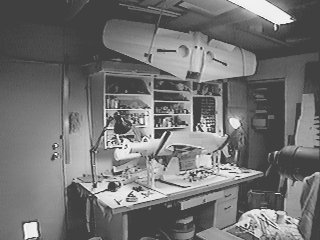

| Wingspan | 70 inches |
| Weight | 17 pounds |
| Wing Area | 1006 sq. in. |
| Wing Loading | 39 oz./sq. in. |
| Front Engine | Saito .90 |
| Rear Engine | Saito .50 |
| Retracts | Robart 630 |
| Finish | Enamels - with Perfect Paint Dead Flat Clear over for fuelproofing |
Title: Dornier 335 Arrow, Monogram Monarch - 2
Authors: Smith, Creek and Hitchcock
Library of Congress Card 96-75250
ISBN 0-914144-52-9
Publisher:
Monogram Aviation Publications
P.O. Box 223
Sturbridge, MA 01566
USA
The book is sold in the USA by:
Zenith Books
1-800-826-6600
The cost is about USD $50. It is 8.5 x 11 inches, hardbound.
The unusual tandem-engined layout of the Pfeil was first patented by Dr. Claude Dornier in 1937, but it was not until the end of 1942 that permission was given to build the first prototype. Perfecting the Pfeil proved to be a long and laborious task and was probably delayed by the skepticism of authorities toward its unusual design. Overheating in the rear engine was but one of the early development problems. The small production run included 3 versions--a single-seat fighter (335A-1); a 2-seat night fighter (335A-6); and "heavy" fighter (335B- series). Toward the end of the war, a night fighter was also produced. Take-off weight was 21,160 pounds, a little less than P-38's 21,600 pounds. First production version A-1 appeared in late 1944, but the course of the war prevented further development.
Further historical info and pictures are available on the aeroflight website.

This article is probably unlike anything you've seen on the web before. I will build this plane - step by step - on these pages. Every assembly will be shown in detail, under construction. We will demystify scratch building in the process. It is not as hard as you might think.
We will be building the 70" Do 335, the second largest of the Do 335 designs that Al sells plans for. It is a complex design. With two engines, four removable hatches (inlcuding the entire upper tail) and scale flaps and retracts, this should be interesting!